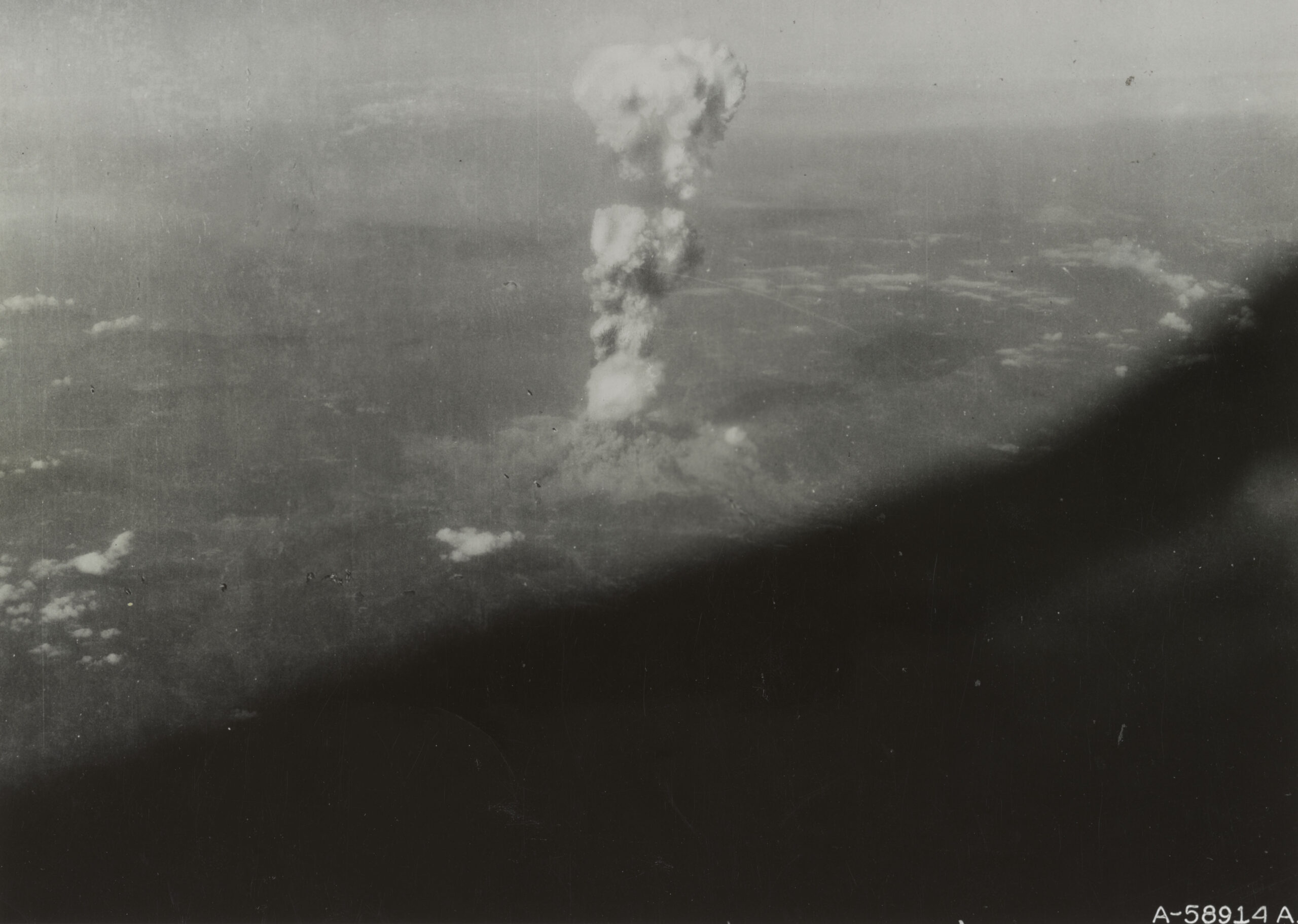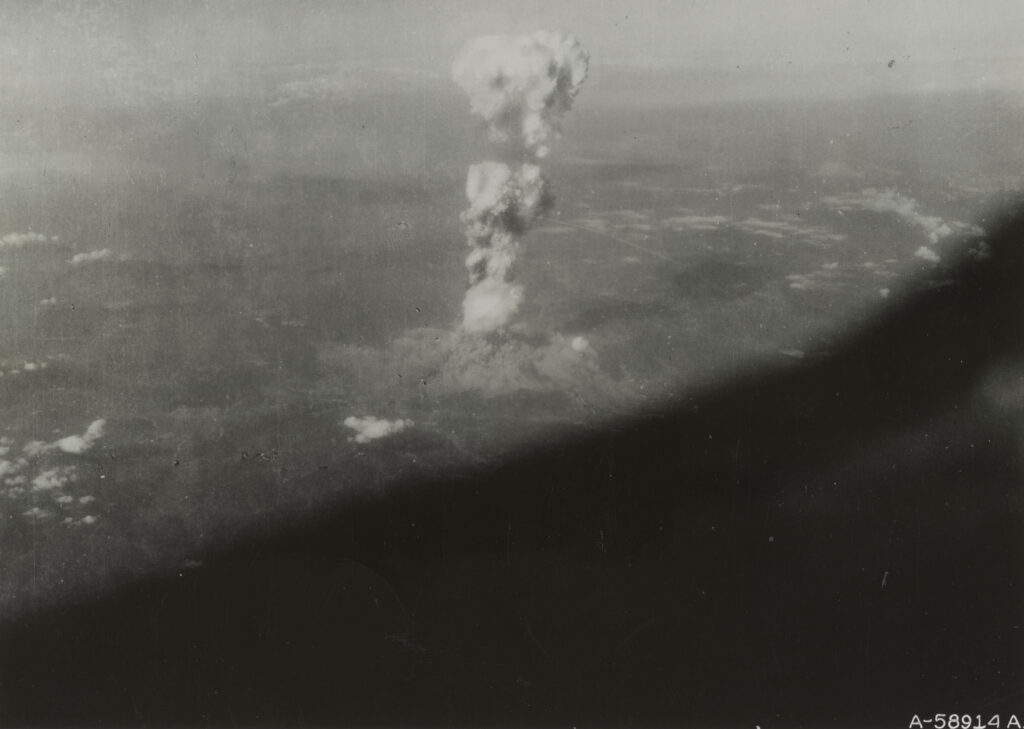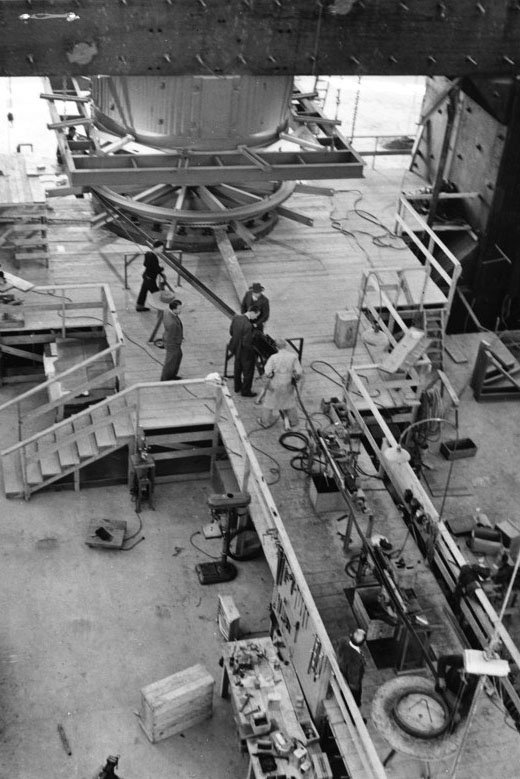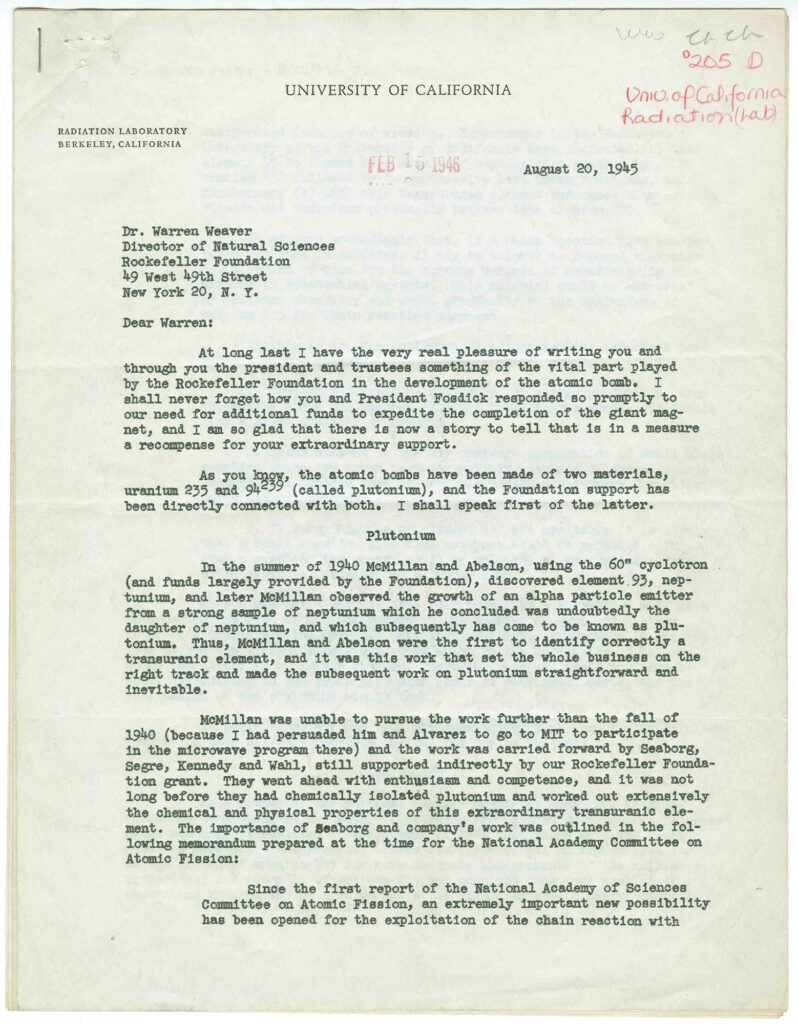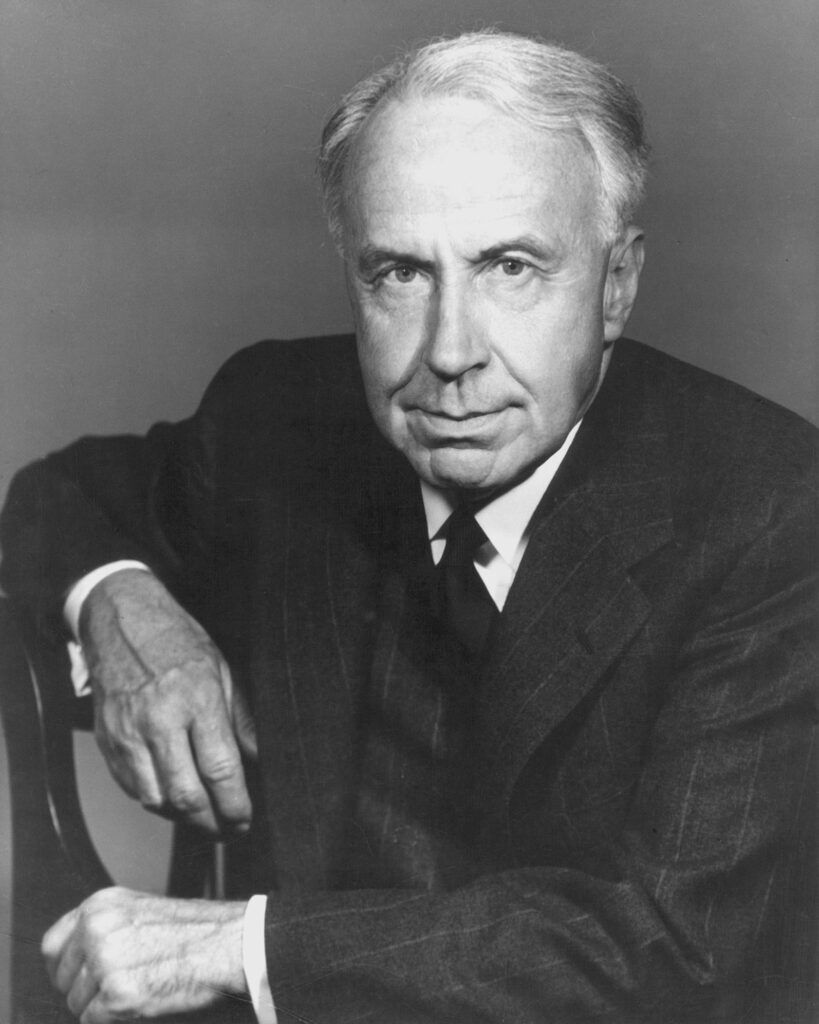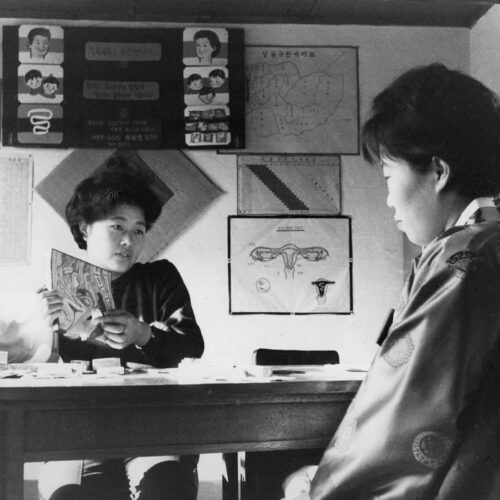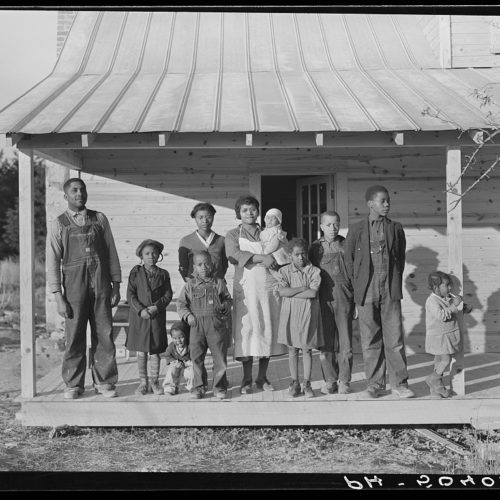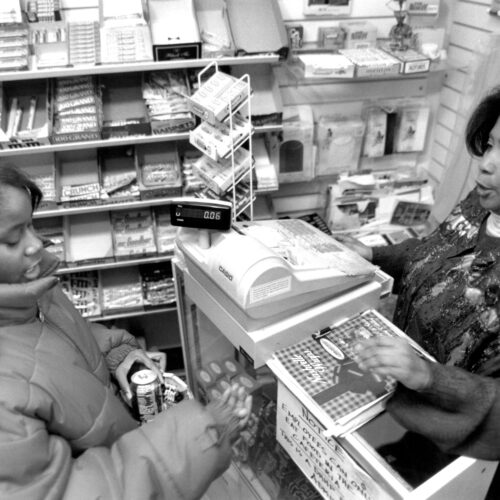In the months immediately after the United States government dropped atomic bombs on Hiroshima and Nagasaki in August 1945, Americans debated the use of those weapons and the possible implications for the future. President Truman announced the bomb’s use in a radio address delivered only 16 hours after the bomb was dropped on Hiroshima:
It is an atomic bomb. It is a harnessing of the basic power of the universe. The force from which the sun draws its power has been loosed against those who brought war to the Far East.
President Truman Speech
Truman described the events that led to the building of the bomb, his determination to use it in the war against Japan, and his hope for the future use of atomic energy. The decision touched off a national debate in the weeks and months after Japan surrendered–and for decades to come.This essay is based in part on a teaching module created by Consultant Dennis J. Maika. For Truman’s speech.
Within the Rockefeller Foundation (RF) the use of the atomic bomb was also cause for debate, in part, because the Foundation played a role in its creation. Indeed, distinguished physicist Dr. Ernest O. Lawrence would go so far as to tell RF President Raymond Fosdick “that if it hadn’t been for the RF, there would have been no atomic bomb.”Letter from Raymond B. Fosdick to Warren Weaver, September 20, 1945, Rockefeller Archive Center (RAC), RG 1.1, Series 205D, Box 13, Folder 191. Although he meant it as a statement of gratitude for RF support, the idea that they shared some responsibility for the bomb’s creation was deeply unsettling to many within the Foundation.
The Origins of the Atomic Bomb
Between 1938 and 1939, the Rockefeller Foundation made $80,000 in grants to the University of California to build and operate a large cyclotron under Lawrence’s direction. The 60-inch cyclotron, completed in 1939, was the largest in the world. In 1940, the RF followed up with subsequent $1,150,000 grant to build an even larger, 184-inch cyclotron.
Lawrence realized that the 184-inch machine had an important potential military application: its 4,200-ton magnet could be used to separate large quantities of uranium 235, which could be used to build an atomic bomb. He asked the RF’s Director for the Natural Sciences, Warren Weaver, if the Foundation would consider making an additional $60,000 grant to help speed up the construction of the magnet. But when he sought to explain his reasoning, Weaver told him not to. He recalled telling Lawrence,
I know why you want it, and if you don’t tell me, then I will be in possession of no secret information and I will be under no handicaps. I think it’s quite clear that you’ve got to get the $60,000.
Warren Weaver
Weaver relayed the details of Lawrence’s request to Fosdick. Weaver recalled,
You see, I could tell him what was afoot because nobody had told me in any official or confidential or secret terms what was afoot. . . . I told Mr. Fosdick that I thought that some way or other we just had to give it to him. We were, however, up against the extremely curious circumstance that we couldn’t possibly explain why.
Warren WeaverExcerpt from “Reminiscences of Dr. Warren Weaver, transcript of interviews conducted by Oral History Research Office, Columbia University. Vol. III, 1961,” RAC, RG 13, Box 14.
The RF trustees took Fosdick and Weaver at their word that the grant was essential, and approved it. The magnet was completed in May 1942, and with it Lawrence and his team were able to demonstrate how larger quantities of Uranium 235 could be produced. The U.S. government then took up the work, and developed enough fissionable material to produce the first atomic bombs.
An Internal Debate
On August 20, 1945, shortly after the atomic bombs were dropped over Hiroshima and Nagasaki, Lawrence penned a letter to Weaver expressing his gratitude. He emphasized that the RF played a “vital part” in the bomb’s development:
It was indeed the existence of the great magnet that made it seem possible that we might be able to get somewhere on the problem [of separating enough U-235] in time to be of value in this war.
Ernest O. Lawrence to Warren WeaverLetter from Ernest O. Lawrence to Warren Weaver, August 20, 1945, RAC, RG 1.1, Series 205D, Box 13, Folder 191.
The RF played a vital part in other ways, as well. A large number of the researchers who helped create the atomic bomb–23 in total–had received grants or fellowships from Rockefeller entities, including J. Robert Oppenheimer, Leo Szilard, Niels Bohr, Arthur H. Compton, and Enrico Fermi. Most of this support was granted in the 1920s and 1930s, when the RF was working to develop the field of theoretical physics; at the time, they could not have fathomed that it would be used to develop an atomic bomb.
Not all RF staff received this news enthusiastically. Fosdick, in particular, was devastated and disillusioned by the wartime experience; he admitted that he felt no pride in the RF’s role in the bomb’s development, and that his “conscience was deeply troubled.” In a series of letters, Fosdick and Weaver debated the outcome. In addition to having a troubled conscience, Fosdick lamented that the United States had “legitimized the use of the atomic bomb as a weapon of war. We have made it respectable. . . . We have given it our moral sanction.”Letter from Raymond B. Fosdick to Warren Weaver, August 29, 1945, RAC, RG 3.2, Series 900, Box 31, Folder 167.
Weaver, on the other hand, saw the development of the bomb as a foregone conclusion, and that it was only a matter of whether the United States or another country would develop it first. He was less certain about whether the U.S. should have used the atomic bomb. But he returned to what he described as “the practical issues”: “Did the atomic bomb shorten the war; did it save American and Japanese lives; does it constitute an irresistible compulsion for the world to organize itself into a decent and peaceful pattern? I think there is a better than even chance that the answers are all affirmative.”Letter from Warren Weaver to Raymond B. Fosdick, September 10, 1945, RAC, RG 3.2, Series 900, Box 31, Folder 167.
Other RF staff weighed in as well. Vice President Thomas Appleget suggested that, given the Foundation’s long history of funding science throughout the world, it was perhaps inevitable that the RF would play a role in the development of the bomb. The result, however, was that “now we share in the awful responsibility for the future use of atomic energy.”Letter from Thomas B. Appleget to Raymond B. Fosdick, September 12, 1945, RAC, RG 1.1, Series 205D, Box 13, Folder 191. The Foundation took this responsibility seriously, and it would influence the Foundation’s work in the postwar decades.
We have given it our moral sanction.
Raymond Fosdick, August 29, 1945
“To Build a World, Not to Flatten It”
In the postwar period, the Foundation was much more cautious in its embrace of science. It turned instead to investing heavily in the social sciences, and focusing on questions of postwar peace through international relations, foreign policy, and area studies programs.
In 1945, a $25,000 grant was made to a conference on the social implications of the atomic bomb. This was followed by additional grants to study American public opinion about the atomic bomb, and to study commercial atomic power. The Foundation also appropriated $300,000 in grants to the Social Science Research Council to help young social scientists return to their studies or resume careers disrupted by the war. In his description of these grants, Fosdick wrote,
Like the atomic bombs, this is a stock pile for the future, but the purpose is to build a world, not to flatten it.The Rockefeller Foundation, Annual Report 1945 (New York: The Rockefeller Foundation, 1945), 13.
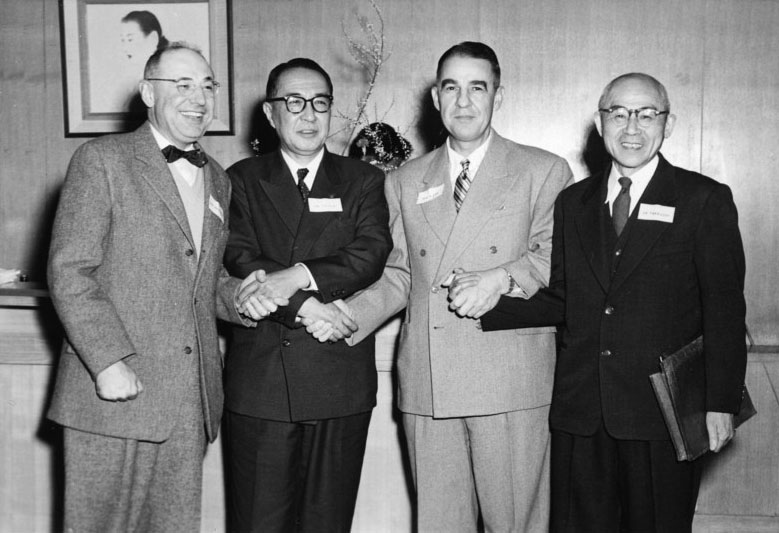
After the war, the RF supported many convenings to consider the future of world peace in the nuclear age.
The social sciences received the highest level of funding of any division in the Foundation between 1946 and 1951. The Division’s program officers grappled with a question succinctly posed by Fosdick in his 1945 President’s Review:
Can education and tolerance and understanding and creative intelligence run fast enough to keep us abreast with our own mounting capacity to destroy? . . . Science must help us in the answer, but the main decision lies within ourselves.Rockefeller Foundation Annual Report 1945, p.10.
Within the Foundation, the legacy of the atomic bomb would continue to be deeply felt for years to come.
Research This Topic in the Archives
Explore this topic by viewing records, many of which are digitized, through our online archival discovery system.
- “Cornell University – Atomic Bomb,” 1946-1954. Rockefeller Foundation records, Projects (Grants), Record Group 1, Subgroup 1.1, United States, Series 200, Social Sciences, Subseries 200.S, Rockefeller Archive Center.
- “University of California – Radiation,” 1933-1940 February. Rockefeller Foundation records, Projects (Grants), Record Group 1, Subgroup 1.1, California, Series 205, Natural Sciences and Agriculture, Subseries 205.D, Rockefeller Archive Center.
- “University of California – Radiation,” 1940 March-1950. Rockefeller Foundation records, Projects (Grants), Record Group 1, Subgroup 1.1, California, Series 205, Natural Sciences and Agriculture, Subseries 205.D, Rockefeller Archive Center.
- “University of Chicago – Atomic Energy – (Commercial Uses),” 1945-1951. Rockefeller Foundation records, Projects (Grants), Record Group 1, Subgroup 1.2, Illinois, Series 216, Social Sciences, Subseries 216.S, Rockefeller Archive Center.
- “Program and Policy – Atomic Energy,” 1945-1947, 1954-1957, 1959. Rockefeller Foundation records, Administration, Program and Policy, Record Group 3, Subgroup 3.2, General Program and Policy, Series 900, Rockefeller Archive Center.
- “Program and Policy – Report – Fahs, Charles B. – Comments on Japan and Suggestions for Rockefeller Foundation Policy There – Pro-3,” January 26, 1948. Rockefeller Foundation records, Projects (Grants), Record Group 1, Subgroup 1.2, Asia, Series 600, General (No Program), Subseries 600.GEN, Rockefeller Archive Center.
- “Rehabilitation Program,” 1947-1950. Rockefeller Foundation records, Projects (Grants), Record Group 1, Subgroup 1.2, Europe, Series 700, General (No Program), Subseries 700.GEN, Rockefeller Archive Center.
- “Warren Weaver,” 1961. Rockefeller Foundation records, Oral Histories, Record Group 13, Rockefeller Archive Center.
- “Atomic Bomb Casualty Commission,” circa 1905-1980. Rockefeller Foundation records, Photographs, International, Series 100, Rockefeller Archive Center.
The Rockefeller Archive Center originally published this content in 2013 as part of an online exhibit called 100 Years: The Rockefeller Foundation (later retitled The Rockefeller Foundation. A Digital History). It was migrated to its current home on RE:source in 2022.
